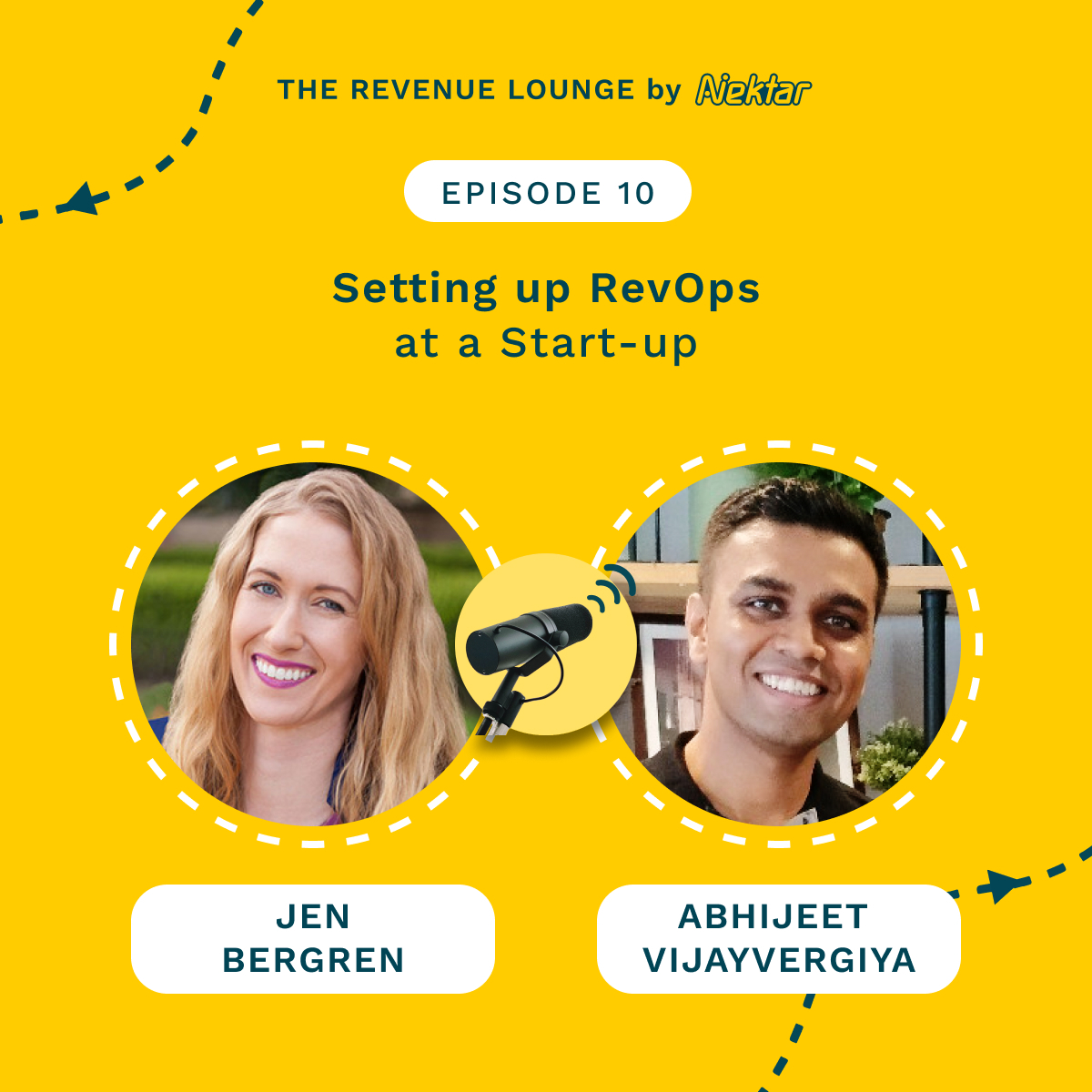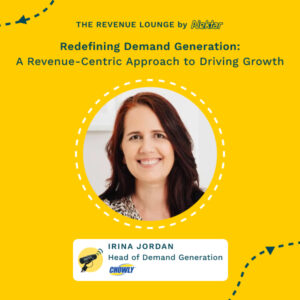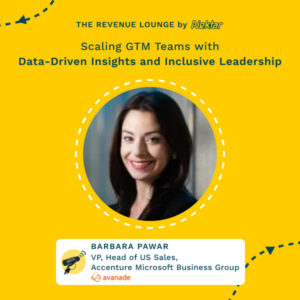Scaling RevOps: Strategies for Enterprise Success ft. Shantanu Mishra
July 24, 2024
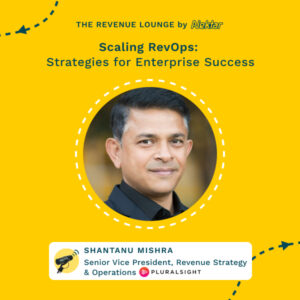
About
The Revenue Lounge
The podcast covers stories from leaders across RevOps, Sales, Customer Success, GTM, Data and Marketing about what drives these functions and what advice they would share with our listeners. With 3 seasons recorded, the podcast currently features 50+ enterprise leaders in the B2B SaaS domain. Tune in to hear from the best in the business
In this conversation on the Revenue Lounge podcast, host Randy Likas speaks with Shantanu Mishra, SVP of Revenue Strategy & Operations at Pluralsight, about optimizing revenue through strategies for building and scaling a revenue operations team. They discuss required skills, effective operating models, using metrics and KPIs, integrating systems, real-world examples, and emerging rev ops technologies.
Main Discussion Points:
– Defining revenue operations and its role in managing the full customer journey
– Strategies for building a rev ops team based on company stage and maturity
– Organizational design – horizontal vs. vertical functions
– Hiring the right skills and talent for rev ops roles
– The importance of data infrastructure and avoiding silos
– Key metrics across the customer journey to measure and optimize
– Components of an effective operating rhythm and cadence
– Conducting win/loss analysis to understand sales performance
– The future impact of AI on identifying target customers, tracking signals and more
Guest Bio:
Shantanu Mishra is SVP of Revenue Strategy & Operations at Pluralsight, with over 20 years experience leading sales operations, strategy and customer success teams at companies like Dell.
Company Bio:
Pluralsight is a privately-held technology workforce development company offering tech skill development products for businesses and individuals.
Key Quotes:
“Revenue operations is about how can you get more leads, how can you convert more at every stage of a conversion, how can you do it faster.” (00:04:03)
“If the pipeline is clean, you get a forecast. If the pipeline is not clean, then you’re wasting time on opportunities and pipeline that are not going to give you results.” (00:08:29)
“There’s volume in talent, there’s quality in talent. The volume I find, I think because of the market conditions that have prevailed over the last 12 to 18 months, there’s lots of resumes out there. And that’s when the challenge becomes, how do you identify the right quality?” (00:18:10)

[00:00:00] As organizations transform and grow, the need to optimize revenue processes becomes essential for sustaining and accelerating business growth. It’s critical to know the strategies that can be employed to build and expand a RevOps team within the enterprise, the skills required for success, and the main components of an effective operating model.
[00:00:17] In today’s episode, we will discuss these topics and best practices for leveraging tools and technologies, the importance of metrics and KPIs, and the challenges of integrating disparate systems. Additionally, we’ll dive into real world examples of streamlined processes and examine the emerging technologies shaping the future of rev ups.
[00:00:35] Hello everyone. Welcome to the Revenue Lounge Podcast. I am your host, Randy Likas. And joining me today is Shantanu Mishra. , he’s the Senior Vice President of Revenue Strategy and Operations at Pluralsight. He has more than 20 years of experience leading large multifunctional teams for sales strategy and operations, inside sales, and customer success.
[00:00:54] while carrying out transformational impact for the organizations that he has been a part of. Shantanu, thank you so much for joining me today. [00:01:00] Nice to meet you and thanks for having me on the podcast. Looking forward to the discussion. Yeah, me as well. So let’s start out and just talk a little bit about, , yourself, like how’s your career progressed and how’s that evolved and gotten you to your role today at Pluralsight.
[00:01:13] First of all, was it all scripted and planned by me 20 years back? Definitely not. I think, , growing up in India, I did my engineering. I came to U. S. for my MBA. I’m based in Austin, been here 21 years. And post India, I worked at Dell for almost 12 years. We have a variety of roles that were various functions within sales operations.
[00:01:37] And as we know that, it used to be There wasn’t a thing called sales operations. It became sales operations, and then it has slowly evolved into what we now call revenue operations. So it has been going through its own transformation journey, and I think my career has mostly followed that. , Postel, over the last eight years, I’ve been working at, , multiple, I’ve been working at multiple midsize, [00:02:00] mostly software companies in a transformational capacity.
[00:02:02] Sometimes in a corporate transformation, strategic transformation roles, but mostly in revenue operations. , building processes, teams, fixing things that are broken. So that’s how, I just landed at Pluralsight, which is a private equity owned company, a mid size B2B SaaS company. So what do you think about building out a revenue operations team.
[00:02:23] , what’s sort of the critical components or first steps in thinking about creating that team and creating it for scale? Got it. So, building out revenue operations, one, there are so many definitions for revenue operations. So we need to understand what is our definition of revenue operations.
[00:02:39] I have a certain definition, which I’ll share with you guys. And the second critical factor that plays in here is at what stage is your company? Are you an early stage zero to 10 million? Are you 10 to a hundred million dollars? Are you greater than a hundred million dollars? And based on that, your journey is defined.
[00:02:56] The way I look at revenue operations, as [00:03:00] like a bow tie, right? We have always heard of the funnel. We understand what the funnel is, but if you take that vertical funnel, you lay it sideways, right? And it becomes lead, lead to opportunities, opportunities to win. But in a SAS environment, you don’t stop at win.
[00:03:17] The second stage of the journey starts where it is about where you have the customer, you have to onboard the customer, which means both the IT systems have to start talking. The customers have to know how to use your software. Softwares are pretty complicated, , things that many times, it’s not intuitive, not very easy.
[00:03:31] So how do you get them on board? And then how does the customer realize the value, right? And again, I’m talking about the right hand side of the bowtie. And then finally, okay. The customer has realized where value, now it’s time to renew and expand that entire bowtie that has to be, , managed. That is what revenue operations is.
[00:03:49] So it is about how can you get more leads? How can you convert more, at every stage of the conversion? How can you do it faster? How can you , make sure that onboarding of the customers [00:04:00] is very fast and smooth. The time to value is fast and then have the right, , expansion and renewal conversation with the customers.
[00:04:09] And to do all of these things, you need the underlying strategy, underlying data, tools, processes, enablement, And then there are functions like forecasting, quota, deletery, compensation, all of those things have to be done. Now, when you are a zero to 10 million company, what you are basically thinking about is where are my next 10 customers going to be?
[00:04:29] I have two salespeople and all you are thinking about is, okay, let’s do some basic homegrown CRM. Let’s do some basic compensation and quota management and make sure that everyone gets paid. As you go to something larger. Now you have to start thinking about, okay, now we are a 50 million, 100 million company, but that’s when a true rev ops leader will start thinking about the day when the company is 500 billion.
[00:04:57] Right. And it’s like, when you’re looking to [00:05:00] build a house, you have to know the blueprint of the house. You have to plan for plumbing, electrical foundation, how big the foundation has to be. How deep the foundation has to be because you have to be planning for is the building going to be one story or 22 stories.
[00:05:13] So to have that vision and you start planning for all of those things that becomes critical. So what culture do you want to establish? What kind of talent do you want to bring in? The talent that you bring in the early stages is you need more of an athletes. But as you start growing, you need to, you still need athletes, but you need some builders.
[00:05:33] You can build things from ground up and take care of every detail. You need people who are very strategic in nature. You need people with specialization in process, tools, , data, et cetera, et cetera. So having that vision is very, very critical, , depending upon the stage and, depending upon how well you understand, , the revenue operations, what is the role of revenue operations in the organization.
[00:05:56] I love that you talk about the bowtie, right? And because, , [00:06:00] expansion , and renewals is you can’t have a leaky bucket, right? For, in order to grow, we have to make sure that we can secure as much revenue as we can. So I love that you talk about it that way. So as you think about the bowtie, how do the metrics change or do they change and what metrics , are you looking at the business to make sure you’re building towards a healthy business?
[00:06:16] Absolutely. I mean, if you look at the metrics. Metrics is something that, , if not planned well, it can drive everyone crazy, right? You will want metrics for all the different time frames, week over week, year over year, quarter over quarter. You will want it for the entire sales hierarchy, for entire success hierarchy.
[00:06:39] You will need metrics for forecasting, pipeline growth, so many things, right? And, , the metrics that I’d recommend, I put them in a few different categories, right? For example, I start with, , forecasting. So for forecasting, you define what that few metrics. I think one of the critical ones is you set an accuracy [00:07:00] goal.
[00:07:01] The forecast that we provide in week four, the final results we want within plus or minus 2% of that, and depending upon how good your forecasting process is. You could start with plus or minus 5%, but the whole class is plus, plus or minus 2%. Then some of the questions that you have to ask is when do you start forecasting the next quarter?
[00:07:21] Right? You get into a weekly rhythm, , and you start, , forecasting the quarter, but do you also want to introduce, do you want to forecast the next week as well? Right? Do you want forecasting for the next week to be as rigorous? Then you start talking about the next set of metrics that I have around pipeline.
[00:07:38] How much pipeline do you have to generate? Right? So you have to understand the entire funnel, the left hand side of the bowtie. So how much pipeline do you need to generate? Then pipeline progression. , usually what I do is I look at close plus commit as a percentage of the forecast to measure pipeline progression.
[00:07:55] The coverage, how much coverage do you have on the current quarter? And at different times of the quarter, you need a [00:08:00] different coverage because early on in the quarter, you need more coverage. But by the time you get into month three, you need lower coverage. You have to keep an eye on the coverage for the next quarter, for hygiene.
[00:08:10] You have to have some kind of a measurement for hygiene because this is something that is very critical. Opportunities. They have to be clean. That’s how the pipeline is clean. If the pipeline is clean, you get a good forecast, you’re not wasting time on opportunities and pipeline that are not going to yield you results.
[00:08:24] Then there’s velocity. Very critical. Velocity. Growth. How many leads are you generating? What is the conversion rate at every stage? What is the average order value? What is the wind rate? Are you winning one out of 10 or five out of 10? And how do you increase the wind rate? Because in growing SaaS companies, velocity, conversion rate, these things are very, very critical.
[00:08:44] Unit economics. I, these are very, very critical to me because if you have to scale the company, What you want is , you invest 1 and you want more than 1. In fact, a lot more than 1 on the other side of it, right? Yeah. For 1 of investment, how much bookings are you getting? How much pipeline are you [00:09:00] getting?
[00:09:00] Right? LTV to CAC, quota to OTE ratios, right? Bookings per wrapsome unit economics. Profitability and market, right? Yes, SaaS is a margin rich business. But you know what? There are , new competitors coming up every day. Right. Right. , many of them, they have pricing as their strategy.
[00:09:17] Sometimes they have product and pricing as their strategy. So how much are you discounting? Right? So keep an eye on that through the deal desk process and do a will loss analysis. Very, very critical. And then on the other side of the whole, what you need to understand are some of the customer health metrics, the license redemption rate, , monthly active users, , that you have, What is your channel and downside and being able to do.
[00:09:41] Full,, renewal pipeline as well. Because when we talk about pipeline, we always think of, okay, we need to win. But the pipeline on the other side is equally critical. , we have started engaging the customers six months in advance, nine months in advance, especially for the larger customers. So is your [00:10:00] deal ready?
[00:10:01] Have you proposed your deal? Are you in a negotiation phase? You don’t want to do these things. In the last three months, you want to start this journey six to nine months in advance and have the right measurements in place. So these are some of the standard metrics that I have, that I recommend.
[00:10:15] And plus there’s always going to be ad hoc analysis and ad hoc metrics to keep track of. So in order to meet those metrics or make sure the business is tracking those metrics, you probably have to have the right, athletes or builders, , within your team to be able to make sure that we’re able to capture those.
[00:10:32] And , Can we talk about, , the organizational design components, specifically around RevOps? So you’ve got maybe a strategy group, you’ve got a team responsible for, , marketing operations, you know, maybe customer success operations, you might have a team, , responsible for tools. We’d love to understand, when you think , about implementing or, , bringing your athletes and your builders into the organization, how do you think about structurally how you do that in order to make sure that you’re aligning with that?
[00:10:55] To get , those, inputs for the metrics that we just talked about. Definitely. I think a great [00:11:00] question here. And again, , this is where I have seen good, bad, , and, , I’m in the process of trying to implement what I think is the best, right? Now, what do we have to manage? We have to manage the whole time, right?
[00:11:13] That’s one factor. The second factor is every company has gone through an evolution journey of how the robots team has worked. So some form of sales operations, then suddenly, Hey, we need to put in. Success operations as well. And then there’s dealers and enablement and strategy and data. All of these teams are there.
[00:11:34] And one of the questions that, , challenges that many companies faces when you ask for strategy or data, you will get strategy or data that the sales focus or success focus on marketing focused. So it is siloed, which is one of the most common things that we get to hear is that it is still very siloed.
[00:11:52] So one of the things that I do is I ask myself, the question is, what are the things which I need [00:12:00] horizontally, which are equally applicable to the entire bow tie and what are the things which are vertically applicable to marketing only, mostly applicable to sales, mostly applicable to customer success.
[00:12:12] The things that I feel are horizontal are strategy. You need to have a single revenue engine strategy. Your investment planning. By that investment plan, because you’re scaling up. How many more sales people do you need? How many more marketing funds do you need? How many more success people do you need?
[00:12:28] Right? Investment strategy. And you have to manage your unit economics as well, so that you are scaling profitably. Data definitely has to be, , an horizontal function. Because if you ask for funnel, you will get, And companies that have not implemented data horizontally, you will get marketing funnel.
[00:12:47] Hey, we generate top of the funnel. We generate leads and these are the MQLs that we got. But sales has its own funnel and success mostly doesn’t have a funnel, but what you need is an end to end comprehensive view and [00:13:00] obviously deal desk, enablement, , commission design, , compensation design. These things are, , horizontal functions.
[00:13:07] Then there are things which need to be vertical. The territory design has to be vertical. The sales territory and the success territory have to be designed independently. Right? , the quotas, they have to be designed, vertically. , the forecasting process. While the underlying tool and the rigor and the plus minus 2 percent expectation has to be horizontal.
[00:13:32] But the forecasting process, the weekly rhythm that everything goes to has to be vertical functions. And then there are sales plays and customer success plays that you run every now and then because there’s an opportunity that needs to be tapped in. So those individual things have to be handled on a vertical basis.
[00:13:47] So that’s the organizational design that I recommend. And then that tells you what kind of talent you need. What kind of, , cultural fit you need, so on and so forth. Yeah. So let’s dig in on the talent, , piece for a moment. Because, as [00:14:00] you mentioned earlier, like Rev ops hasn’t been along around all that long, right?
[00:14:04] It was sales ops, for a , long time. And now as we’ve thought about looking at revenue more holistically or, across the entire bow tie. , there’s people that I think, , maybe we’re generalists in a different role that, , have gone into operations, but can you talk a little about like, how do you find the right talent or recruit the right talent for the functions that we just spoke about?
[00:14:24] And what are some of the key skills that maybe you look for , in hiring somebody for your team? Absolutely. I think a few things that I prioritize. One, when I’m looking for, , my director polls, who are leaders themselves. I look for people who compliment me. Very, very critical. I have a few skill sets.
[00:14:41] There are many things which I don’t do well. There are things that I just do okay. So I need people who compliment me, right? And , same principle should apply when those, Leaders who are reporting into me when they’re looking to have their team look for people who complement them. The second thing that is very, very critical for me is eq.
[00:14:58] We a venture [00:15:00] backed company. We a private equity backed company. We a publicly held company or some other form of holding the corporate world is getting faster and faster. There are more changes that are happening. You have to interact with 10 different people. You are going down one path, there would be a change in direction.
[00:15:16] How would people handle these changes? Do they have that emotional stability or are they, Hey, it’s another change. I don’t like it. We failed this time. Or how do they take all of these things? So, , these are some of the very critical things. , then as I was saying, there are some athletes that you need within the team, right?
[00:15:33] Who can do multiple functions. You need builders, you need strategic people, , process, rigor, data people, people with some financial acumen, right? You need people with a mix of ambition. You need some people who are very ambitious, who want to grow, but you don’t want your team to be full of people who are very, very ambitious, right?
[00:15:53] So, the usual places where I go for looking these kind Uh, talent, and it depends on the role that I’m hiring for. [00:16:00] People who are , part of the finance team usually tend to do very well with , the data side of things. Mm-Hmm. , if they bring in the operational expertise as well, then they can fit in more than one role.
[00:16:09] Then we have, , tools and processes. But the tools and processes, you need people more with business analyst kind of, expertise. So people who have been in the IT organization who understand technology, they can be, , people who show the right acumen, who go from an IT analyst to a business analyst, from an IT developer to a business, , analyst, and they all usually tend to be
[00:16:32] good friends. You can look for strategy functions. For, many of the analytics functions, market research that we need to do. , you need , people with consulting backgrounds, they tend to do right on there. Consulting background, proper strategy. They tend to very good, right? And then, , there are some people who are just very detail oriented.
[00:16:50] They just want to build something and do something really, really well. So you have to look for those kind of skill sets as well. Mm-Hmm. . Enablement is something where you need [00:17:00] people who can hold the attention of the room. You don’t want an enablement guy or person to come into the room and just read the slides.
[00:17:06] You need a very engaging personality, right? Yeah. People should be like, okay, we are going to have an enablement session with this person. It’s going to be fun. We will not only be learning about tools and processes and new stuff, but we will be having some labs. So, those are some of the critical things that I look for.
[00:17:22] And how have you found the market these days, like, in trying to build out, , the right team? You know, as RevUp is getting more popularity, I think I saw on LinkedIn, like, it’s the fastest growing skill set right now. , is it rough out there to find the right talent, or, what’s been your experience, this year?
[00:17:39] There’s volume and there’s quality. Volume I find, uh, I think because of the market conditions that, uh, have prevailed over the last 12 to 18 months. There’s lots of resumes available. And that’s when the challenge becomes how do you identify the right quality? So knowing what you need, having clarity as to what you need is one challenge.[00:18:00]
[00:18:00] The second challenge is And any candidate goes for three or four interviews and each person has like 30 to 45 minutes, right? Being able to assess their EQ, their strategic agility and functional expertise becomes a challenge. How do you do that? And therefore, there are a couple of tricks that I employ.
[00:18:21] Not tricks, but these are just fairly standard interview practices that I do. One is, I look for analytical capabilities, so give them a problem, right? Give them some data, give them a problem, and say, Hey, take a couple of days and come back to us and show us what your answer is. So the first , 15 minutes they present the answer, and then you ask them a few questions and you see how they go through that.
[00:18:43] That’s one of the things that you can do. The other thing that I do in my interviews is, and I’m letting out one of my interview secrets, is you, I ask the candidate, tell me about your best project. Tell me about your best achievement. Because if there is something that you are really proud of, what I’m looking to [00:19:00] understand is, did you understand what was the problem?
[00:19:03] How well did you understand the problem? What did you do? What were the cross functional dependencies? And what was the result of the outcome? If someone is able to articulate one of the biggest achievements, then that candidate likely is a strong candidate. On the other hand, if someone is not even able to articulate what their biggest achievement is, then that person definitely is not a strong candidate because if you can’t talk about your best work, one project, one achievement in a very articulate man, then definitely that person doesn’t pass my sniff test.
[00:19:38] Yeah. It also, I think, , gives you a little bit of insight into how much they plan for an interview, right? They should be thinking about these things going in as well. Yeah. , so I’d like to transition a little bit into data and talk about data. So , you mentioned it earlier about, you need to be careful that you’re not building these, , vertical silos of data.
[00:19:57] And so there’s a lot of tools right now that are out there available [00:20:00] for RevOps professionals, , across the bow tie. And so how do you make sure that you design Systems and what systems I guess maybe do you put in place to make sure you’re capturing the data that you need in order to inform those metrics that we spoke about earlier and not create silo data or a silo data.
[00:20:19] You’re going to have it no matter what. You just have to minimize it as much as possible. We just love to hear you talk about how do you manage the data issue so I really appreciate it. Thank you. There is data and tools. I think Randy I heard two things and let me know if you want me to address both or just one of them.
[00:20:33] , both please. But let’s start with data and then because, , the tools should follow the data, right? Absolutely. Absolutely. So, , data. Data is one of the most critical things. This is one of the things which can either be an asset or become a liability if not planned well, right? And when you think of all the different kinds of data that is used in analyzing the entire GTM engine, the entire whole [00:21:00] time, right?
[00:21:00] There’s billing, entitlement, contracts, data, there’s product related data that’s coming in, right? How are the customers using our data? There’s data coming from all the marketing automation tools, right? The CRM tools, the workflow tools, , these days we have, , multiple new tools around, , tracking activity, conversational intelligence.
[00:21:17] So there’s data coming in from there. There’s data that needs to come from the HR systems, right? How many people do we have? How many are ramped up? How many are not ramped up? What’s the average, employee churn rate, et cetera. And then you have the account data, right? So you buy the account data and you buy enrichment data.
[00:21:33] And how’s the account data? And, so you can see it’s a very, , Yeah. And the data infrastructure and need to be set up early on. I have seen companies where all of these data sets, they are flowing into a centralized database without proper data engineering team, and hence the responsibility, a lot of the responsibility of funding.
[00:21:57] Creating the right data tables falls on the shoulders of [00:22:00] revenue operations. So, yes, all these data points that are flowing into a centralized database, it is the revenue operations analytics team that need to have some data engineering kind of skill set to build their own tables. That is not the best solution.
[00:22:14] What I would recommend is, as companies start going beyond 10 million in ARR, right, start investing in data engineering because you already have billing systems, product marketing, all of these data elements are already beginning to be collected. Invest in the right cloud based, right backend centralized database.
[00:22:35] Invest in the data engineering team that’s bringing in the data. , and then the revenue operations team, it has to go in and say, okay, these are all the metrics, the KPIs that we talked about from forecasting pipeline unit economics. So revenue operations team should go ahead and define that these are the metrics.
[00:22:51] So now you know what the end state looks like. Now you have clean organized data that has been done by the data engineering team on the backend. And then the [00:23:00] data tables need to be designed in between to meet all of these KPIs. And when you have all of these data and KPIs and depending upon the investment or the growth trajectory or the state of the company, you can invest in data visualization tools, automation tools that sits on top of these data tables.
[00:23:19] And automates lots of these metrics for you all. We can continue to use Excel and Google Sheets until we get to a stage where we can invest in data visualization tools. So we’ve seen a trend, where a lot of go to market organizations, to your point earlier, are having their own data teams built within them and they’re recognizing that the tools, , that they’ve put in place by default aren’t writing everything back to their system of truth, maybe their CRM.
[00:23:46] And so They’re saying like, that’s okay. We are going to build a data warehouse, whatever. Pick your tool. So we can put all of our go to market data in there , and look at that way. Is that a similar strategy , that you seeing as well as like, let’s create a data warehouse [00:24:00] to make up for some of these.
[00:24:01] , disparate data gaps, or are you still under the philosophy of we need to put everything in the CRM because that’s our source of truth. , unfortunately what I have seen is, , where companies have had a mix of both the things. Some tools, the data from some tools are going into the CRM.
[00:24:16] And some of the rest of the tools that are going into this, , big data warehouse in the back end. Right? And. This is, I think, because of the natural evolution, the fast growth that companies go through and what’s the shortest path to get this data recorded either in the CRM or in , the data warehouse.
[00:24:35] And that is where an experienced data engineering leader, having that person, bringing that person early on who has a vision as to what five years down the road should look like, , helps. And because all of these things, they make. Retrieving the data, modifying the data, how fast the data visualization tools stay refreshed.
[00:24:56] Because many times when I work with my data visualization tools, I choose a [00:25:00] filter, I select a filter and it takes 10, 20, 30 seconds for the data to refresh, right? So the underlying data design impacts all of these things. So having that vision early on and having that plan early on is very, very critical.
[00:25:12] And this also becomes a very critical point is when you are bringing in a new. Right. Evaluating a new tool, revenue operations has done the evolution or the assessment, , the IT team has done the assessment, the sales teams and the success teams, they have done the assessments, have we brought in the data engineering leader to do their assessment, how easily can the data flow.
[00:25:33] Yeah. So these are some of the things which by through mistakes and through experience, I think we have learned and, , I think given an opportunity in the future, I would like, these are some of the things which I would like to do differently from how, , I have seen in the recent past. What, in your experience, , RevApps, , as a function, , should it report through the CRO or should we report through, , the finance organization?
[00:25:54] , in your experience, what have you seen work best? See, I always believe that the reporting structure, [00:26:00] is not the most critical factor in what op design works best. And this is not only for, the revenue optimization reporting, but for any organization. Reporting structure is one of the factors.
[00:26:12] The critical factor is operating model and operating rhythm. As , someone who has led, revenue operations function, I’ve reported into the CRO, I’ve reported into the CFO. And there are pros and cons when you report it to the CRO, then you are too close to the CRO. Are you able to build a relationship where you are able to tell the CRO the good from the bad and this is working, this is not working, right?
[00:26:36] If you are reporting in a CFO organization or in some cases I’ve seen that the leader of the revenue operations is a peer to, the CRO and the CFO, , then it becomes, okay. Are you part of the CRO family? Are you trying to help us? So there are pros and cons in both. It is more about how the relationships are managed.
[00:26:58] What is the operating [00:27:00] rhythm? What is the operating model? Setting up those things, the culture is another keyword, which I should emphasize on is very, very critical. If you are able to build those trusted relationships where you can have those honest conversations and be able to, jointly hold each other accountable.
[00:27:16] Those things are more critical than the reporting structure. Yeah. So that’s interesting because, um, I, in preparation for our conversation, I was doing a little bit of research and I saw, I think it was two weeks ago, that Pluralsight came out with the announcement like , new operating model that you’re going to follow.
[00:27:32] And as a result of that, some new senior leadership appointments lead in different areas. And speaking of about the relationships. What advice might you give to other leaders out there who , maybe have a new business model change or have new people? What’s the best practice in terms of building those relationships with your peers?
[00:27:47] Relationship building is always very tricky and the higher up you go, , more difficult it becomes, right? And a lot of it comes down to trust, like in any relationship in life or within the corporate world, it comes down to trust. Do I [00:28:00] trust your ability? Do I trust your intentions?
[00:28:04] Right? And, , some of the things that one needs to do is, , I think have those honest conversations, right, up front. Try, and especially when, , you have new leaders within the organization, Being able to spend time outside the office in a more relaxed environment where you are talking something other than numbers, PBTN process, that helps us when you get to know each other as a human being.
[00:28:26] Because if you think of it, , when you go VP level and higher, , many of us, we spend more of our time, let’s say we are awake for 16 hours in a day. Hopefully we get eight hours of sleep, which is, at least I don’t get that. But, , of the 16 hours of the day when you are active, you are spending more than 50 percent of that time, , with your office colleagues, , with your peers, back to five days a week.
[00:28:52] Sometimes a little more than five days a week. So having that comfort, , builds trust. Being able to [00:29:00] open up. Both at a personal level helps having those honest conversations helps. And to have those honest conversations, what you need to have proper preparation. You need to have good listening skills as well.
[00:29:12] Try to understand what the priorities for the other person are. And, just don’t be limited to, hey, this is what I prepared and this is what I will share. So, , gently lay it out so that, , be able to receive the feedback and receive the signals that the other person is trying to give you.
[00:29:34] Very, very critical. That’s really, really great advice. You mentioned a few times earlier, , the idea of an operating rhythm and having that right operating rhythm or cadence, of the business. What have you found to be the most effective? , is it monthly? Is it quarterly? And what do you review in those operating rhythms?
[00:29:52] Everything we’ve kind of talked about earlier as far as metrics. , what’s been your experience with that? You definitely need a weekly and a quarterly. [00:30:00] That’s for sure, right? And all the sort of KPIs that I had defined, I basically put them into buckets. These need to be tracked weekly.
[00:30:10] And these are the ones that are weekly. , that will only give you the right signals when tracked or when measured quarterly. Like example, most of the unit economics, they need to be quarterly because the cost will be spread evenly across the three months, but the bookings, they will always have a hockey stick.
[00:30:27] So if you look at the unit economics for month one, they will look terrible, right? And then by the time you complete the quarter, the unit economics, they will stabilize. So you have to, , get into that. , the question is, do you need anything monthly or not? And what I recommend, and again, you have to balance between, okay, how much more data do I want to generate?
[00:30:49] How much more, burden do I want to, of another meeting, another preparation that needs to happen and slides, or tableau or Excel sheet, whatever needs to be done. [00:31:00] So what I recommend is. , and then the last one is weekly, quarterly, very rigorous processes and monthly make it more of a report that goes out rather than having a two hour session or where you have 10 different people coming in, right?
[00:31:12] But in all of these things, the critical thing is how do you make this information which is being shared, whether it is in the form of a report that’s going out, whether it is in the form of a meeting that is happening, whether it is in the form of a four hour planning session that is happening. How do you make that meaningful?
[00:31:31] So defining work, standardizing, aligning, and presenting the right insights and metrics rather than just dumping data, , that planning and preparation, which a lot of that falls on the revenue operations becomes very critical. You also mentioned something earlier, which I think falls into , the operating rhythm is the win loss analysis.
[00:31:50] We’re hearing more and more of that. How often are you doing that and what are you specifically looking for in those win loss analysis to help? Derive an insight that you can actually, it [00:32:00] could be impactful. , will loss analysis, I think it should, the data should be collected daily. But, , will loss analysis on a quarterly basis, , makes sense.
[00:32:09] But, since , the data is being done daily, then there’s the deal desk team , that has their, , ears very close to the ground as to what kind of deals are going through. , there’s the DevOps teams that are looking at data. And certainly if you start. Start finding that, hey, we are seeing a abnormal behavior.
[00:32:25] We are seeing lots of unusually large discounting that’s happening, or we are discounting at the usual levels, but we are not seeing the same sort of, , win rates that is happening, or we are having to give more concessions right, to the customers. So that should immediately, that should bubble up very quickly to the leadership.
[00:32:48] Why is this happening? For that, I don’t want us to wait till quarter. Now in win loss, the things that you want to understand is separate the wins from the losses. We won [00:33:00] deals. Why did we win? What are the average price per license discounting that we are winning? What are the other, , deal levels that we are proposing?
[00:33:08] Who are we winning against? Right? So being able to understand, is it our product? Is it our value proposition? Was it our sales process? Was it our pricing? Why are we winning? Losses are equally critical, right? And this is when you, we have to train our sales and success people to keep their ears very close to the ground.
[00:33:29] And this should be part of the deal review processes. Who are the competitors in the process? What is it that the customer is looking for? And, , then once we lose deals, especially deals of any significant size, one of the habits that we should develop within the organization is for the sales teams to get back to the customer and understand what happened, what could we have done better. And then through the loss analysis, bring it back to the customer.
[00:33:52] So there’s feedback from the customers that’s coming in through the sales and success people. There’s data that they’re populating [00:34:00] in. And then what about the loss indicator, , whatever tool we have to capture that those deal loss. , the win or loss indicators. There’s a deal desk analysis that can help you in that.
[00:34:11] So using a combination of all of these things. We should keep our ears , very close to the ground to make sure that we understand why we are winning, why we are losing. Is there a new competitor in the market? Is there a competitor that has certainly changed its strategy? Is there some weakness in our ecosystem because of which we are losing?
[00:34:31] Or is there a certain strength that we are not realizing because of which we are winning more deals? And then you fine tune your value proposition, you do an enablement exercise and make sure that all costs its people. And success people, they are enabled with the latest information so that we can win more and replicate the success.
[00:34:50] Very insightful. Thank you , for sharing that. What are some of the emerging technologies that you think are going to have the biggest impact on rev ops , in the near [00:35:00] future? , so what’s your take on some of the impact of AI maybe, or other ways in which you can drive more efficiency in the rev ops function?
[00:35:07] , the obvious answer is, , A. I. Yeah. A. I. is, fundamentally changing the way we understand everything. It’s making it easier. Now, just saying that A. I. will change, , is a very simplistic answer. , in fact, if you do a double click, some of the things which I’m hoping, and I’ve already seen some, , some green shoots in these areas, , helping me identify where my ICPs are.
[00:35:31] I mean, we know who our ICP is, what our ideal customer profile is, where are they? Who are those ICPs? Who are the ones that our sales team should go ahead and contact. So being able to identify the ICPs, because if you think of it, many of the social networking tools, they know so much about us.
[00:35:48] They can tell us what we like, what we don’t like, how do we dress, what do we eat, what do we technology and so on and so forth. So I’m sure that there’s data out there that can help us identify where our ICP is. The second [00:36:00] thing is, , intent data. There are many customers, many people out there who are looking to buy solutions that we are looking to sell.
[00:36:07] How do you capture this intent data and send signals, , into our GTM engine so that we can proactively contact those customers? We have eight. So getting that intent data, early warning system. Hey, , we have an early warning system, both, both from a market perspective or from our customer’s perspective.
[00:36:28] Hey, the customer health indicators and everything, it’s saying that it’s looking , mostly green, but this is what I’m seeing is happening. There are other factors that are happening and what are those factors? , can there be an AI tool that can tell us. What, how our competitors are engaging with our customers?
[00:36:45] Can we get some signals there? That would be very, very interesting, right? Some AI that tells us what’s happening in the market. How our competitors are behaving. How’s the market changing? Can we get those signals faster? Right? Yeah. , so all of these different [00:37:00] AI can potentially, and I’m sure there are many other use cases that people are already working on and thinking of.
[00:37:06] Yeah, AI will fundamentally change how we approach our rev ops and g TM engine. So much more, , opportunity than just writing a better email, right. As as far as what’s ahead of us. Absolutely. , alright, let’s transition into more, , personal questions, , and what we call our rapid fire round.
[00:37:21] , so what’s one book maybe that you’ve, you loved in the recent past that you’ve read that you might wanna share with our audience off late? What I’ve been doing a lot are, , listening to. Yeah. , multiple, , avenues that are available and they are across various topics. And there are some of the favorite ones that I have subscribed to, , like, how to build effective storytelling, right?
[00:37:44] Effective communication, effective leadership, RevOps, how is RevOps changing? And I love hearing from what my peers are doing in the industry. , what some of the experts on the field of RevOps, , some, well renowned experts out there. So there are lots of podcasts that I listen to. So there’s not one [00:38:00] specific book, definitely not a book.
[00:38:02] And even there, I have like seven, eight different places that I have to subscribe to, and I don’t remember them off the top of my head. Yeah. I listen to their content on a regular basis, but I don’t remember. Yeah. Well, there and there’s so many good ones out there. Right. So, like you, like I’m a book person.
[00:38:15] I like to read books, but I find podcasts to be, they’re easily consumed. Right. 20, 30, 40 minutes and you’re onto the next. So a hundred percent agree with that. Okay. So you’ve been , in rev ops for, over 20 years. , what’s your favorite part about working in rev ops?
[00:38:29] One is evolving very rapidly, right? So what’s the latest out there? Just like AI is very exciting, RevOps business process perspective, RevOps is very exciting, it’s evolving very rapidly. So just being aware of what’s happening, what the future looks like, how do you make sure that, Amongst the various options, how do you choose the best option?
[00:38:48] The best path as you are trying to build that involves within your current company. So that’s very exciting. The other thing is, in the robots world, life is always exciting. , the team that you manage, the [00:39:00] day to day challenges that come up, , there’s a good quarter that you have had, you celebrate, then the next one you start having a different set of challenges and then you try to solve for them and then they help you set up.
[00:39:09] It’s a rollercoaster ride, so if you like rollercoasters, you’ll love it. Well, so, there’s always a flip side to that question, which is, , least favorite part about working in RevOps? Uh, one of the things that ends up happening with RevOps is it becomes a catch all, right? , hey, there’s a problem with, there’s some product enhancements that needs to be done.
[00:39:30] And we have to work with the product team and get that just acting as the glue and the bridge between GTM functions and product team. Is that really a revolves function? Maybe, maybe not, right? Depending upon how it’s set up. , there’s a new MNA that has happened and there’s a lot of MNA related work that needs to happen.
[00:39:48] A lot of the MNA related work, yes, there’s a role that has to play, but to what extent? So various cases in which it becomes a catch all. [00:40:00] And these are the cases where as a leader, it becomes very critical for me to voice, , to have a point of view, to say, this is what is a good fit. This is where we should look at a different solution.
[00:40:11] Yeah. Okay. Last question. , what’s one piece of advice that you might give to someone who’s in , a athlete or a builder mode right now that wants to be the senior vice president of revenue, , at their company someday. I’ll get you to a rotational program. So, yes, I mean, I did the same thing. I was like, how can I move to the next grade level, next grade level, next grade level?
[00:40:34] And to get to the next grade level, you have to continue working in this very similar functions. If I’m doing data, the next data, next data, next data, right? But to get to, an SVP level or any level where you have to manage a cross functional team and you have to work across multiple different partners, Having a cross functional understanding is very important.
[00:40:55] So sometimes having a career strategy where you are [00:41:00] doing multiple roles, take a stint in finance, take a stint in process and operations, do a stint in analytics, do a stint in corporate strategy, right. So building that horizontal foundation so that when you start growing vertically and trade wise. You are ready for all of these things and you have a 360 degree view of the business.
[00:41:21] So that’s one advice that I would give a younger self of mine and plus all the young revolves enthusiasts. Yeah. I think that’s a great piece of advice. And with that, I’d like to just say, thank you very much for your time today. This was a very insightful conversation. I really enjoyed it. And I know our listeners will as well.
[00:41:39] So have a great weekend and we will talk soon. Like was right. It was wonderful. Thanks for this conversation and and good luck in everything that you do. I thank you. You as well.

Ep #1: Navigating the Downturn with a Hyperfocus on Productivity
Listen Now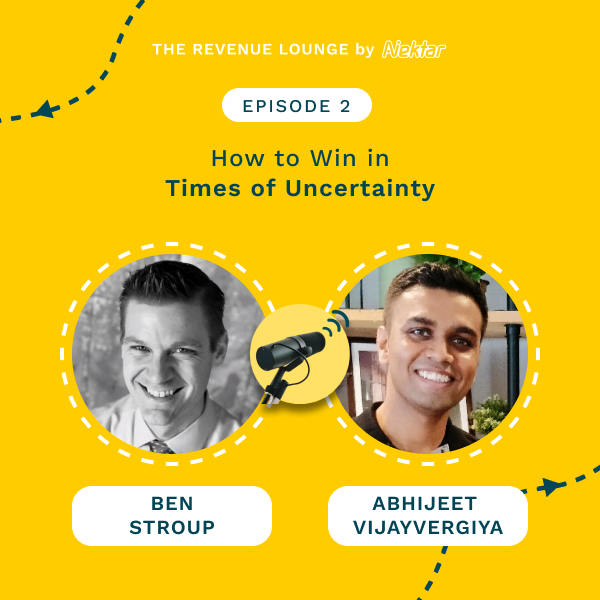
Ep #2: How to Win in Times of Uncertainty
Listen Now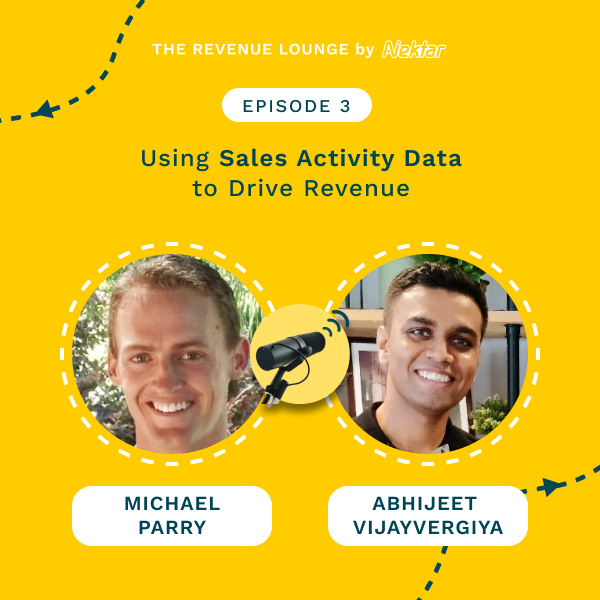
Ep #3: Using Activity Data to Drive Sales Productivity
Listen Now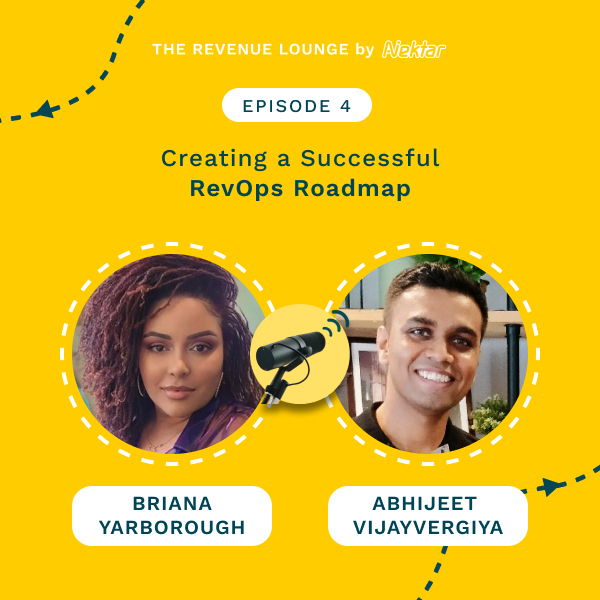
Ep #4: Creating a Successful RevOps Roadmap
Listen Now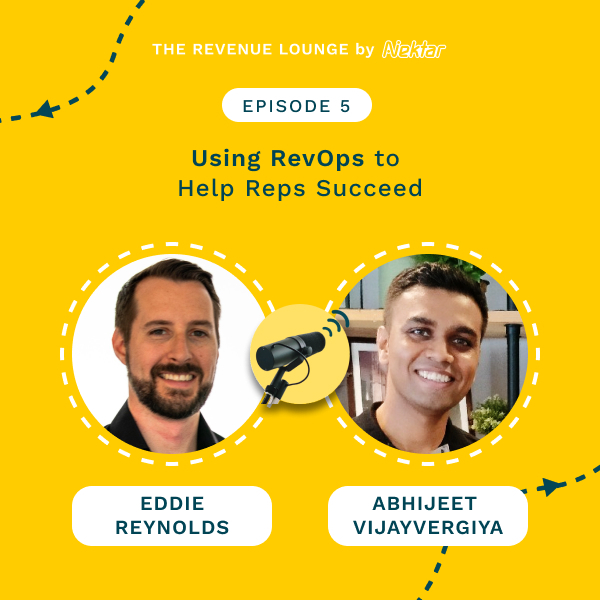
Ep #5: Using RevOps to Help Reps Succeed
Listen Now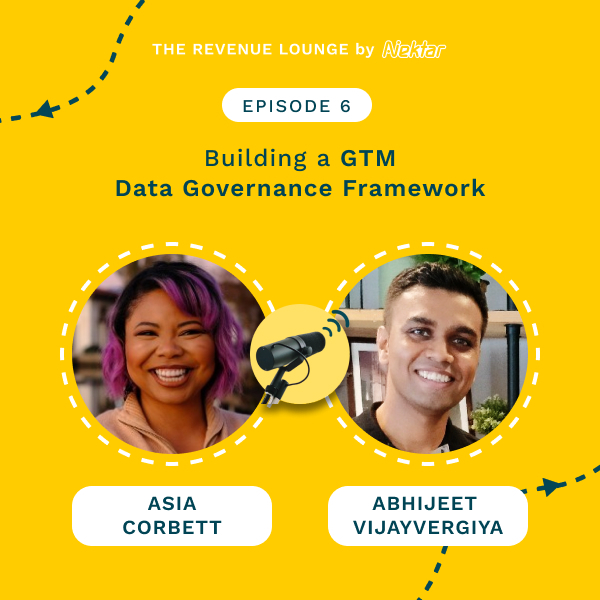
Ep #6: Building a GTM Data Governance Framework
Listen Now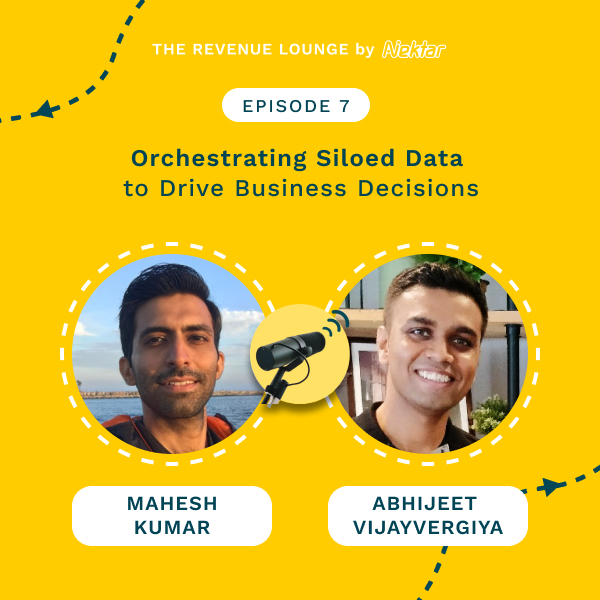
Ep #7: Orchestrating Siloed Data to Drive Business Decisions
Listen Now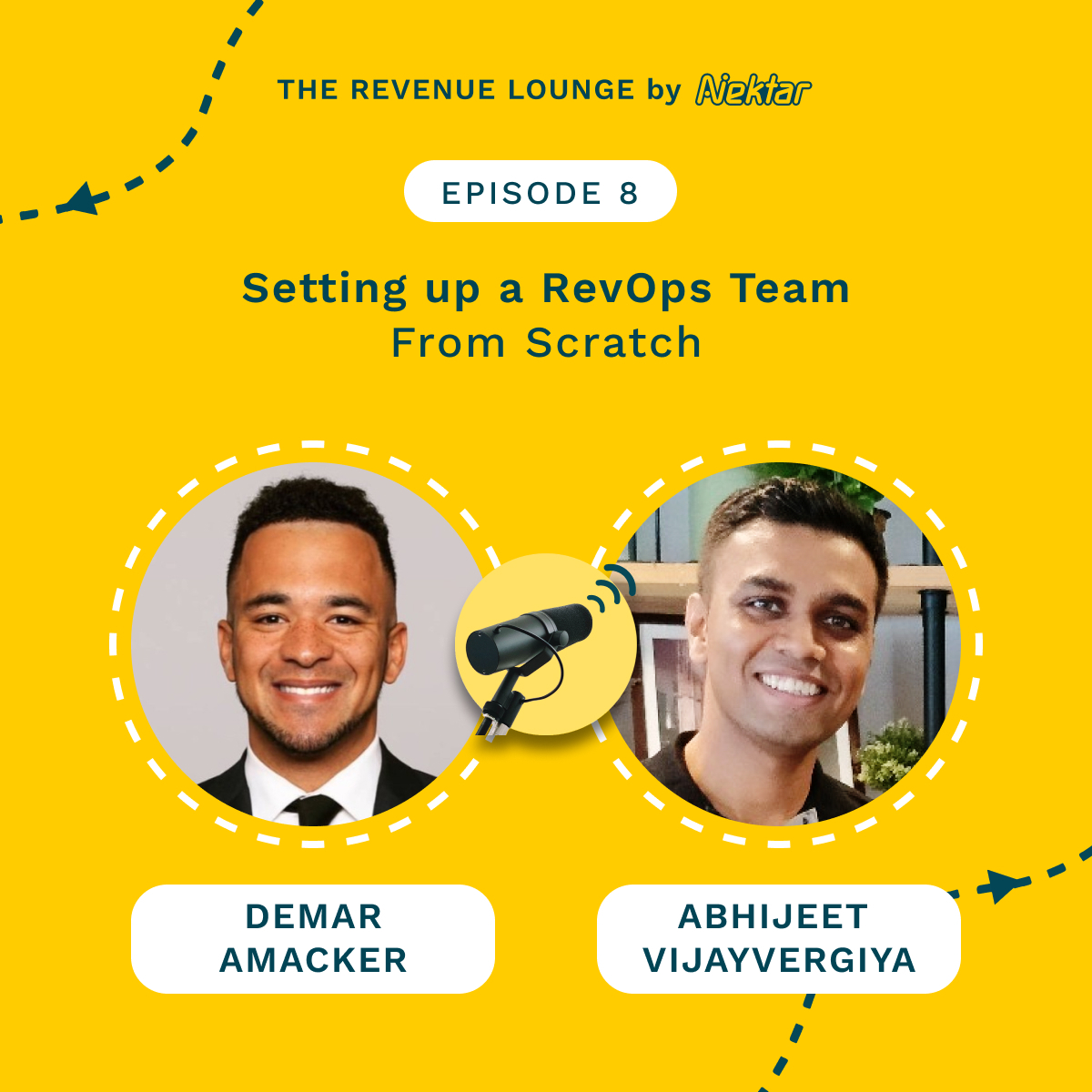
Ep #8: Setting Up a RevOps Team From Scratch
Listen Now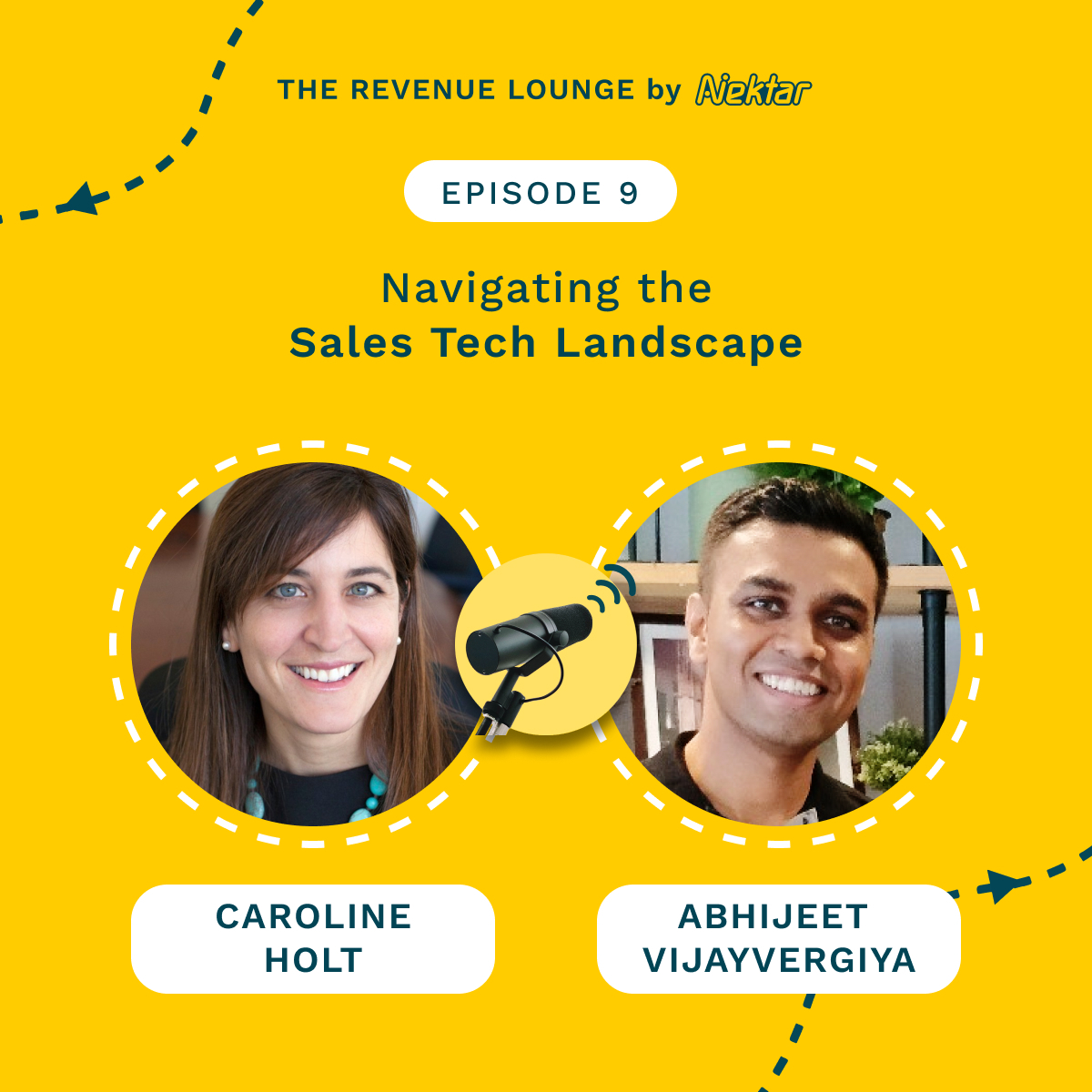
Ep #9: Navigating the Sales Tech Landscape
Listen Now